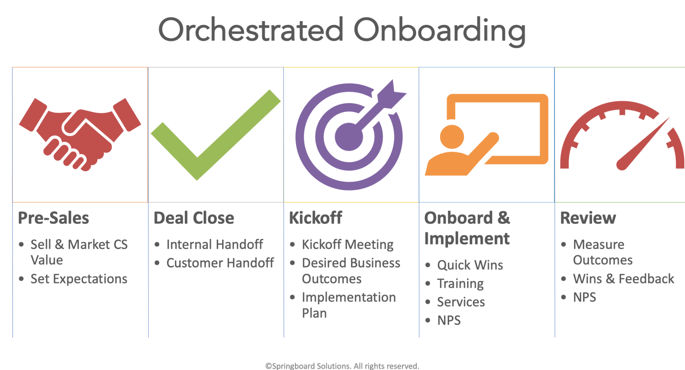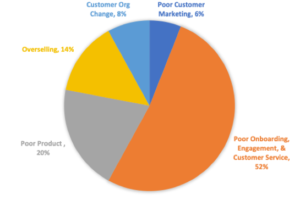Onboarding customers is the most important part of the customer journey and McKinsey says that when you carefully monitor and engage customers throughout rollout, you’re on a path to a lucrative customer relationship. Yet, even though onboarding is vital, it’s the main cause of churn. The image below shows when you group poor engagement and poor customer service with poor onboarding, they add up to 52% of the reason customers leave in those first 90 days. Why is this?
Poor onboarding is the main cause of churn
While the pre-sales journey has matured dramatically over the last ten years, the post-sales journey is still ad hoc. Companies spend time and money turning leads into prospects and prospects into customers. They guide customers along a sophisticated buyer journey with clearly defined milestones, touchpoints, and roles. Tools like Marketo, Hubspot, and Salesforce keep Sales and Marketing teams aligned and data-driven, measuring every phase of the buyer journey.
Then the deal closes, and all that complexity is thrown out the window. Customers struggle to figure out how to use your product and to leverage which services when. They are burdened with connecting the dots between all the customer-facing resources available, like when to log a ticket, take training, call the CSM, or find a knowledge article. Don’t use hope as a strategy for onboarding customers. Instead, front load the relationship with an orchestrated onboarding program and guide customers to success.
What is orchestrated onboarding?
Orchestrated means organizing and planning something that is complicated to achieve a desired or maximum effect. Most companies I talk to do not provide a cohesive approach to onboarding. Instead, each CSM frantically tries to make customers happy. They pick up and attempt to play nearly every instrument in the orchestra for their customers. This results in a confusing and disjointed relationship from the start. On the other hand, when each customer-facing role plays their own instrument, then together they provide a cohesive and harmonious arrangement, which is what customers want.
Onboarding is the action or process of familiarizing new customers with your products and your services. When does onboarding begin and end? That likely depends on your product. It might be 90 seconds for a mobile app, or 90 weeks for a large enterprise software tool. For most business-to-business software companies, 90 days seems to be a good timeframe. What’s most important is whether you know the timeframe that works for your product and for your customers.
Without a successful customer onboarding program, most of your customers will never fully realize the value of your product or service. In fact, ServiceSource indicates that when your customers don’t become loyal users in those first 90 days, their renewal likelihood could drop to as low as 10%. The Customer Success bowtie below shows that when you move from ad hoc to orchestrated onboarding, customers renew, buy more, and they become your champions.
The Customer Success bowtie
What does orchestrated onboarding look like?
Below is a high-level overview of an orchestrated onboarding plan and what to consider at each stage.
- Pre-Sales
– Are you selling and marketing the value of your Customer Success programs?
– Do you emphasize Customer Success programs and onboarding as a key differentiator from your competitors?
– Do Sales reps set customer expectations by talking about the Customer Success programs and onboarding before the deal closes? - Deal Close
– Do you nail the handoffs?
– Do you have an internal handoff meeting with the pre-sales and post-sales teams to hand over the customer relationship and to – share important details about the customer relationship?
– Do you have a customer handoff meeting to formally transition the relationship to the Customer Success teams, and to align the customer teams on their desired business outcomes? - Kickoff
– Do you hold a kickoff meeting before you dive into the implementation?
– Do you validate the customer’s desired business outcomes and determine together which metrics to track the progress?
– Do you provide an overview of working with the CS team and the onboarding and implementation plans? - Onboard & Implement
– Do you determine quick wins for customers to reach during onboarding?
– Do you have scalable customer education and enablement content?
– Do you keep customers accountable? - Review
– Do you measure customer satisfaction at the end of the onboarding period?
– Do you measure and share outcomes with customers?
The key to orchestrated onboarding.
In order for your orchestrated onboarding program to have an impact, you must break down silos. You can’t take customers down a seamless journey when your internal teams aren’t talking to each other. In the article From Touchpoints to Journeys, McKinsey shares that even though your customer-facing programs like Training, Support, Consulting, and Customer Success might be fabulous, customers still leave unsatisfied because they aren’t guided along a journey of best practices.
I believe the post-sales journey will become as sophisticated as the buyer journey. Rather than hoping customers onboard and renew, be prescriptive. Create an orchestrated onboarding journey and build a customer-centric organization to engage customers and to partner towards mutual success. Now it’s time to focus on the customer journey, and that starts with onboarding. Which silo will you break down today?
Learn more about orchestrated onboarding from my blog or reach out to chat with me.
Donna Weber is a Principal with Kickstart Alliance and President of Springboard Solutions. Donna specializes in the post-sales customer success journey. With over 20 years’ experience, she builds programs that enable, on-board, and educate customers, helping hi-tech firms create customers for life.




Trackbacks/Pingbacks